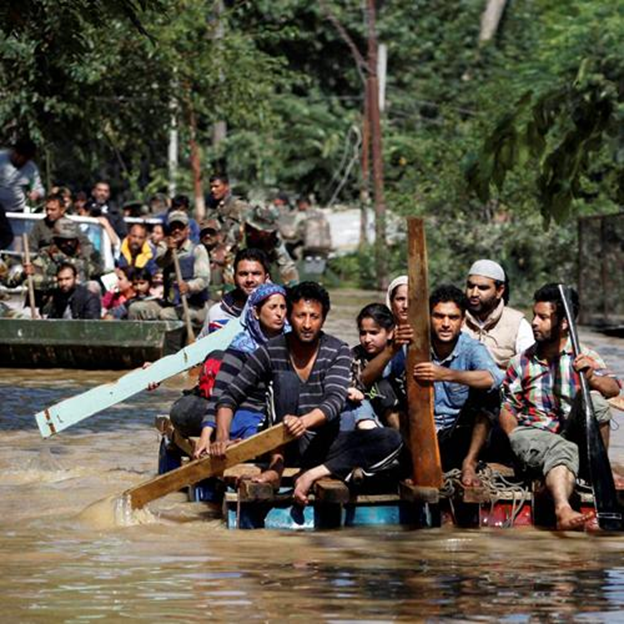The Kashmiri Youth And Their 'Sailing Machines'
Unsung heroes
SRINAGAR: Massive devastation, unbelievable human suffering is now the landscape of Jammu and Kashmir with large swathes of the state covered in now stagnant water. In Srinagar that with South Kashmir bore the brunt of the waters fury major colonies still remain under several feet of water, with the picturesque capital of the state subsumed by a smell of damp and rot as the Kashmiris try and come to terms with entire lives lost.
The stories are terrifying and paint a picture of helplessness, callousness, indifference and apathy. But the darkness is penetrated by light in the shape of Kashmir’s youth who have stunned the older generation with acts of sheer heroism, without even perhaps realising it. The reason why the figures of the dead are still as low as 300 across Jammu and Kashmir is being attributed, not just by the civilians or for that matter the separatists but by government officials, senior mainstream political leaders , journalists and all others The Citizen spoke to, to the young Kashmiris.
The rain waters flooded out South Kashmir in the first instance with entire villages washed away with no warning sounded by the government or its monitoring agencies that are supposed to be reading the danger levels of the rivers ---according to their own admission---every few hours, if not hourly. Some efforts were made to issue warnings to people in Srinagar to evacuate their houses with the government using the mosques and the radio to alert the residents. However, by their own admissions most did not take this seriously with no one, least of all the state government, anticipating the torrential flooding that has destroyed large parts of Jammu and Kashmir.
Resident after resident from all across Srinagar said that the waters came gushing in at great speed, “like a monster rushing after us” and within minutes had climbed to the first storey of the houses. The people ran up without their belongings, and in many areas were not even safe on the second floor and had to move into the attics. It was traumatic, scary with many staying without food and water and with fear for three to nine days before they were rescued either by the Army or by the heroic youth.
In a situation free of suspicion and prejudice, the young Kashmiri youth would have invited accolades and awards. The stories are phenomenal and speak volumes of the dedication and commitment of the young Kashmiris who are receiving a standing applause from all sections of society in Srinagar. They formed rescue teams almost immediately as there was no help of any significance for the first two days when even the government and all its agencies was flooded out. They formed boats by breaking apart cupboards and beds in their homes, tied and nailed these together, put mattresses and started taking people who would not have probably survived otherwise, out of the deluge. They took plastic water tanks, cut these into half and used these to rescue people to drier land. The ‘boats’ were highly innovative but these worked with the youth tying ropes around each other lest they be swept away by the waters.
Residents taking refuge at the Gurudwara relief camps in the city narrated similar stories, of being rescued by young people. In fact in at least two incidents the young people saved the army, and paramilitary personnel when their boats capsized. PDP leader Mehbooba Mufti said that after these specific rescues a strange kind of bonding had taken place between the otherwise opposed sides in the areas, with all working together to bring people to safety.
The Kashmiri youth formed rescue squads, held meetings to try and coordinate efforts although that did not work as well as many of them had wanted, and even with communication disrupted used the grapevine to keep in touch and bolster numbers wherever required. Many did not know how to swim but even so braved the waters. In fact as Hurriyat leader Mirwaiz Omar Farooq said that when he visited one of the areas, the conservative Kashmiri girls said that the first thing they would do would be to learn how to swim.
Congress spokesperson Salman Soz also narrated stories of the young peoples bravery and said that they had done a phenomenal job. And while every political leader including the Mirwaiz was full of appreciation for the Army, the fact remains that the rescue operations insofar as the little side streets submerged under water and far flung areas occupied by the less fortunate were concerned, it was the Kashmiri youth in their strange boats who came to the rescue.
The Army of course did an excellent job and despite one sided reports by the television channels and their editors, The Citizen did not come across a single person who did not appreciate the rescue efforts. However, all decried efforts by sections of the media to pit one against the other. The Army cantonment was itself flooded out and while the Army soldiers worked day and night in rescue operations, there was a protocol they had to follow and began with the VIPs, tourists, and then of course the civilians. The young Kashmiris had no such protocol, and just jumped into the waters to rescue whoever needed to be, without cameras and of course without publicity.
Interestingly journalists too played a major role in rescue operations, forming squads to pull out people. Rising Kashmir’s Shujaat Bukhari spoke of the number of people rescued by his group of scribes from submerged houses, with many others reportedly also in the waters performing the same mission. The newspapers have suffered enormous losses with many losing their printing presses in the floods. However, most have started publishing again or at least updating their online sites.
(Tomorrow: The ‘National’ Media)





